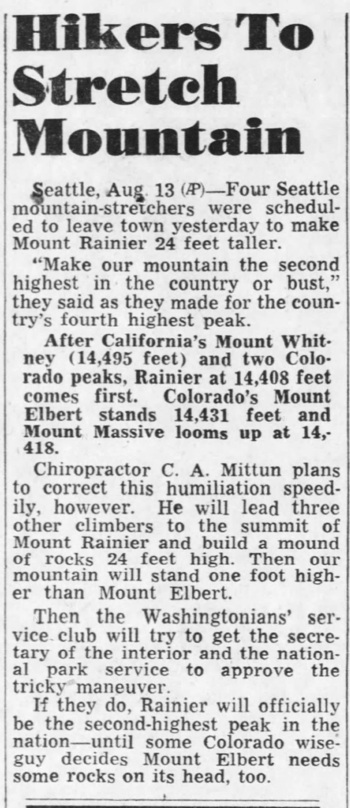Raising Mt. Rainier
In 1948, Washington's Mt. Rainier was considered to be the fourth highest mountain in the U.S., behind California's Mt. Whitney and Colorado's Mt. Elbert and Mt. Massive. But the difference between Rainier and the Colorado mountains was only a few feet. So Seattle chiropractor (and mountain-climbing enthusiast) C.A. Mittun came up with a plan to build a 24-foot mound of rocks on top of Mt. Rainier, thereby leapfrogging it from fourth place into second.
However, their plan never came to fruition. A Colorado-born park superintendent stopped Mittun and his team on their way up, telling them that their plan was illegal.
None of the articles from 1948 about Mittun's plan mentioned Colorado's Mt. Harvard, which Wikipedia lists as being four-feet higher than Mt. Rainier. So sometime between 1948 and now the relative heights of the two mountains must have been adjusted, pushing Mt. Rainier further down the list. When Alaska became a state in 1959, Mt. Rainier fell far down the list to its current spot at #17.
Incidentally, Mt. Harvard has its own history of being artificially raised. In the 1960s a group of Harvard graduates put a 14-foot flagpole on its summit in order to make it the second highest point in the contiguous United States. The flagpole stayed up for about 20 years.


However, their plan never came to fruition. A Colorado-born park superintendent stopped Mittun and his team on their way up, telling them that their plan was illegal.
None of the articles from 1948 about Mittun's plan mentioned Colorado's Mt. Harvard, which Wikipedia lists as being four-feet higher than Mt. Rainier. So sometime between 1948 and now the relative heights of the two mountains must have been adjusted, pushing Mt. Rainier further down the list. When Alaska became a state in 1959, Mt. Rainier fell far down the list to its current spot at #17.
Incidentally, Mt. Harvard has its own history of being artificially raised. In the 1960s a group of Harvard graduates put a 14-foot flagpole on its summit in order to make it the second highest point in the contiguous United States. The flagpole stayed up for about 20 years.

Santa Cruz Sentinel - Aug 13, 1948

Hanford Morning Journal - Aug 17, 1948
Comments
Given that the guy with the brainstorm was a chiropractor, I think the headline should be "Adjusting Mt. Rainier."
Posted by ges on 12/19/23 at 11:02 AM
When I visited this mountain, I learned that the correct name for it is Tahoma, which is the Native American name. Why should we care what obscure British Naval officers, who never did anything of interest, were friends of George Vancouver when Meriwether Lewis was looking around for an English name to put on his map? It's too much of a stretch for me.
Posted by Virtual on 12/21/23 at 05:40 PM
I'm all for renaming Mt. Rainier Mt. Tahoma, or renaming Mt. McKinsley Mt. Denali, but I think we should draw the line at Mt.Mispronounced-and-hard-to-spell-Mohawk-name. Unless the English name is also mispronounced and hard to spell, of course.
Posted by Yudith on 12/23/23 at 07:25 AM
@ges: Is it even possible to break a mountain's spinal chord?
Posted by Richard Bos on 12/24/23 at 09:47 AM
Commenting is not available in this channel entry.

Category: Geography and Maps | Landmarks | 1940s